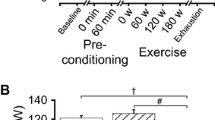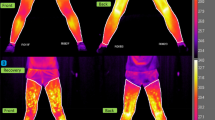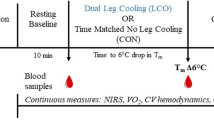Summary
This study examined the effect of exposure of the whole body to moderate cold on blood lactate produced during incremental exercise. Nine subjects were tested in a climatic chamber, the room temperature being controlled either at 30°C or at 10°C. The protocol consisted of exercise increasing in intensity in 35 W increments every 3 min until exhaustion. Oxygen consumption (VO2) was measured during the last minute of each exercise intensity. Blood samples were collected at rest and at exhaustion for the measurement of blood glucose, free fatty acid (FFA), noradrenaline (NA) and adrenaline (A) concentrations and, during the last 15 s of each exercise intensity, for the determination of blood lactate concentration [la−]b. TheVO2 was identical under both environments. At 10°C, as compared to 30°C, the lactate anaerobic threshold (Than, la −) occurred at an exercise intensity 15 W higher and [Than, la −]b was lower for submaximal intensities above the Than, la − Regardless of ambient temperature, glycaemia, A and NA concentrations were higher at exhaustion while FFA was unchanged. At exhaustion the NA concentration was greater at 10°C [15.60 (SEM 3.15) nmol·l−1] than at 30°C [8.64 (SEM 2.37) nmol·l−1]. We concluded that exposure to moderate cold influences the blood lactate produced during incremental exercise. These results suggested that vasoconstriction was partly responsible for the lower [la−]b observed for submaximal high intensities during severe cold exposure.
Similar content being viewed by others
References
Bergh U, Harley H, Lansberg L, Eckblom B (1979) Plasma norepinephrine concentration during submaximal and maximal exercise at lowered skin and core temperatures. Acta Physiol Scand 106:383–384
Blomstrand E, Bergh U, Essen-Gustavsson B, Eckblom B (1984) Influence of low muscle temperature on muscle metabolism during intense dynamic exercise. Acta Physiol Scand 120:229–236
Boutelier C, Timbal J, Colin J (1968) Conductance thermique des tissus périphériques du corps humain plongé dans l'eau froide. J Physiol (Paris) [Suppl] 1:223–224
Brooks GA (1986) Lactate production under fully aerobic conditions: the lactate shuttle during rest and exercise. Fed Proc 45:2924–2929
Claremont A, Nagle F, Reddan W, Brooks G (1975) Comparison of metabolic temperature, heart rate and ventilatory responses to exercise at extreme ambient temperature (0°C and 35°C). Med Sci Sports 7:150–154
Da Prada M, Zurcher G (1976) Simultaneous radioenzymatic determination of plasma and tissue adrenaline, noradrenaline and dopamine within the femtomole range. Life Sci 19:1161–1174
Dole VP, Meinertz H (1960) Microdetermination of long chain fatty acids in plasma and tissues. J Biol Chem 235:2595–2599
Galbo H, Houston ME, Christensen NJ, Holst JJ, Nielsen B, Nygaard E, Suzuki J (1979) The effect of water temperature on the hormonal response to prolonged swimming. Acta Physiol Scand 105:326–337
Hohorst HJL (1965) Lactate determination with lactic dehydrogenase and DPN. In: Bergmeyer HU (ed) Method of enzymatic analysis. Academic Press New York, pp 266–270
Holmer I, Bergh U (1974) Metabolic and thermal response to swimming in water at varying temperatures. J Appl Physiol 37:702–705
Ivy JL, Costill DL, Van Handel PJ, Essig P, Lower RW (1980) Alteration in the lactate threshold with changes in substrate availability. Int J Sport Med 48:523–527
Koike A, Weiler-Ravel D, McKenzie DK, Zannconata S, Wasserman K (1990) Evidence that the metabolic acidosis threshold is the anaerobic threshold. J Appl Physiol 68:2521–2526
Mader A, Liessen H, Heck H, Philippi H, Rost R, Schurch P, Hollmann W (1976) Zur Beurteilung der sportartspezifischen Ausdauerleistungsfähigkeit im Labor. Sportarzt Sportmed 27:80–88
Minaire Y, Pernod A, Jomain MJ, Mottaz M (1971) Lactate turnover and oxidation in normal and adrenal-demedullated dogs during cold exposure. Can J Physiol Pharmacol 49:1063–1070
Ramanathan NL (1966) A new weighing system for mean surface temperature of the human body. J Appl Physiol 19:531–533
Simon J, Young JL, Gutin B, Blood DK, Case RB (1983) Lactate accumulation relative to the anaerobic and respiratory compensation thresholds. J Appl Physiol 54:13–17
Therminarias A, Flore P, Chirpaz MF, Quirion A (1989) Influence of cold exposure on blood lactate response during incremental exercise. Eur J Appl Physiol 58:411–418
Author information
Authors and Affiliations
Rights and permissions
About this article
Cite this article
Flore, P., Therminarias, A., Oddou-Chirpaz, M.F. et al. Influence of moderate cold exposure on blood lactate during incremental exercise. Europ. J. Appl. Physiol. 64, 213–217 (1992). https://doi.org/10.1007/BF00626283
Accepted:
Issue Date:
DOI: https://doi.org/10.1007/BF00626283




